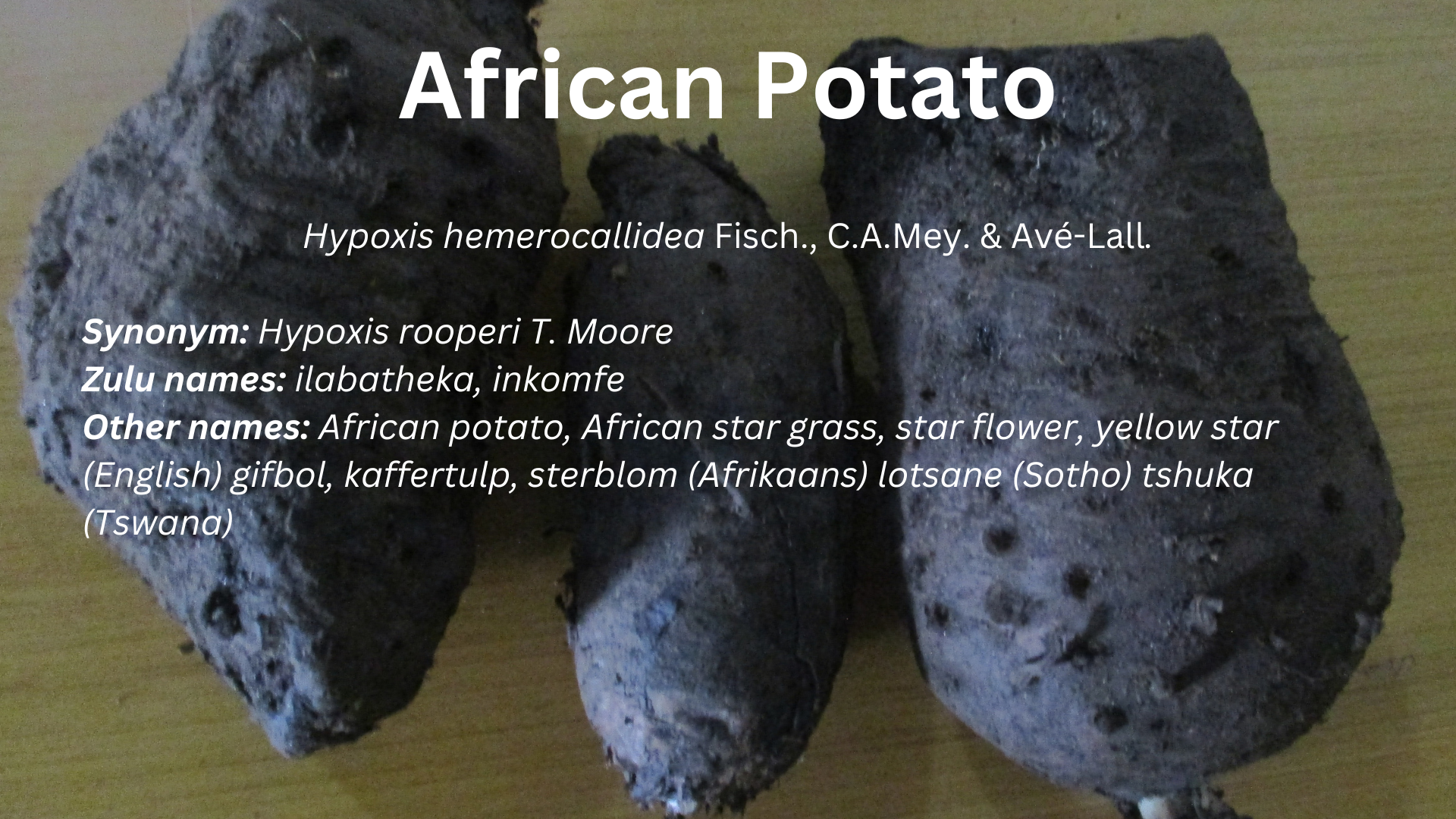Family: Hypoxidaceae
Scientific names: Hypoxis hemerocallidea
Authority: Fisch., C.A.Mey. & Avé-Lall.
Synonym: Hypoxis rooperi T. Moore
Zulu names: ilabatheka, inkomfe
Other names: African potato, African star grass, star flower, yellow star (English) gifbol, kaffertulp, sterblom (Afrikaans) lotsane (Sotho) tshuka (Tswana)
Description: H. hemerocallidea is a tuberous perennial herb and geophyte that is found in grassland habitats and disturbed areas where almost pure stands of the plant occur. It has strap-like leaves that are tristichously arranged, bright yellow star-shaped flowers that open up in the morning and close at midday, and three-chamber capsule fruits that contain small glossy black seeds.
Uses:
- The corm (or root) is cooked like idumbe and eaten to strenghten the body.
- The corm is used to make a decoction that is taken orally to help people who cannot speak due to shock.
- The corm is used as an immune system booster.
- The corm is used to make uzifo zonke, a tonic that cures many different ailments.
- The corm is used to cure boils, persistant and septic wounds and sores, and ringworm.
- The corm is charred or burnt in coals, ground into powder, and made into an ointment that is applied onto sores.
- The corm extract is applied on a wound incured from a burn or injury.
- The corm is used to treat acne, dermatitis, and eczema.
- The corm is used to treat ulcers in the gastro-intestinal tract.
- The corm is used to lowers high blood pressure and treat edematous conditions, haemorrhoids, and varicose veins.
- The corm is used to treat inflammations, back pains, athritis, rheumatism, and high uric acid levels.
- The corm is used to make an infusion that is taken as an emetic to treat dizziness and psychatric disorders.
- The corm is used to treat complications due to prostrate hypertrophy.
- The corm is used to treat bladder and urinary tract infections.
- The corm is used to treat opportunistic infections.
- This plant is used as a tonic to ease childbirth.
- This plant is used to treat ailments caused by teething in children.
- The plant is used to make a decoction that is administered as a tonic to weakly children.
- In Maputaland the corm is used to treat gynaecological and obstetrics ailments, including gonorrhoea, internal and external sores, genital warts, and urinary tract related ailments.
- The plant is used for protection.
The responsible use of traditional medicine can yield good results, however misuse and abuse can be detrimental to ones help. Consult the appropriate people before using traditional medicine for the best results.
Reference and further reading:
- Bayley, A.D., 1993. The biosynthesis and production of hypoxoside in Hypoxis hemerocallidea Fisch. and Mey. in vivo and in vitro.
- Cunningham, A.B. 1988. An investigation of the herbal medicine trade in KwaZulu Natal. Institute of Natural Resources Investigative Report Issue 29. Institute of Natural Resources, Pietermaritzburg.
- De Wet, H., Nciki, S. and Van Vuuren, S.F., 2013. Medicinal plants used for the treatment of various skin disorders by a rural community in northern Maputaland, South Africa. Journal of Ethnobiology and Ethnomedicine 9, pp.51.
- De Wet, H. and Ngubane. S.C. 2014. Traditional herbal remedies used by women in a rural community in northern Maputaland (South Africa) for the treatment of gynecology and obstetrics complaints. South African Journal of Botany 94, pp.129–139.
- De Wet, H., Ramulondi, M. and Ngcobo, Z.N. 2016. The use of indigenous medicine for the treatment of hypertension by a rural community in northern Maputaland, South Africa. South African Journal of Botany 103, pp.78–88.
- Hutchings, A., Scott, A.H., Lewis, G. and Cunningham, A. 1996. Zulu medicinal plants. Natal University Press, Pietermaritzburg.
- Naidoo, D., Van Vuuren, S.F., Van Zyl, R.L. and De Wet, H., 2013. Plants traditionally used individually and in combination to treat sexually transmitted infections in northern Maputaland, South Africa: Antimicrobial activity and cytotoxicity. Journal of Ethnopharmacology 149, pp.656–667.
- Nciki, S., Van Vuuren, S., Van Eyk, A. and De Wet, H., 2016. Plants used to treat skin diseases in northern Maputaland, South Africa: antimicrobial activity and in vitro permeability studies. Journal of Pharmaceutical Biology 6, pp.2420–2436.
- Ncube, B., Ndhlala, A.R., Okem, A., and Van Staden, J. 2012. In vitro antimicrobial synergisms within plant extract combinations from three South African medicinal bulbs. Journal of Ethnopharmacology 139, pp.81–89.
- Pegel, K.H. 1979. Active plant extracts of Hypoxidaceae and their use. United States Patent: 4160860 .
- Pujol, J., 1990. Natur Africa: The Herbalist handbook. Lean Pujol Natural Healers Foundation, Durban.
- Smith, C.A. 1966. Common Names of South African Plants. Department of Agricultural Technical Services. Botanical Survey Memoir No.35. Government Printer. Pretoria. pp.544.
- Watt, J.M. and Breyer-Brandwijk, M.G., 1962. Medicinal and poisonous plants of southern and eastern Africa, second edition. Livingstone, London.
- Wood, S.E. 1976. A contribution to the knowledge of the genus Hypoxis L. (Hypoxidaceae) in Natal, South Africa. M.Sc. Thesis. University of Natal, Pietermaritzburg.
